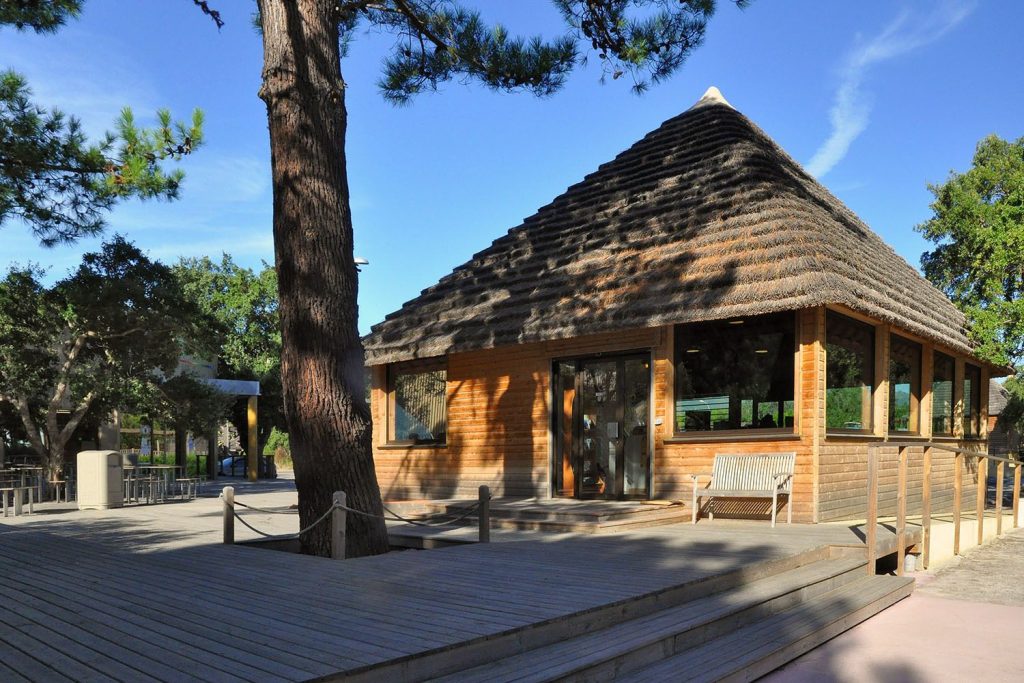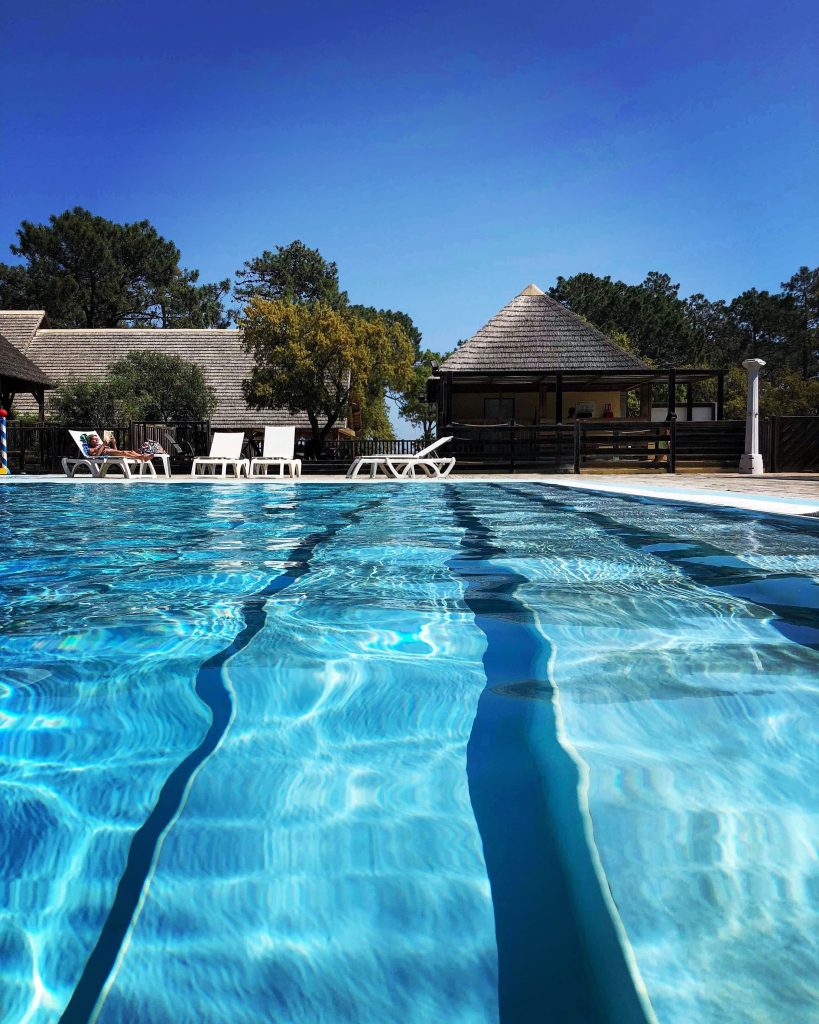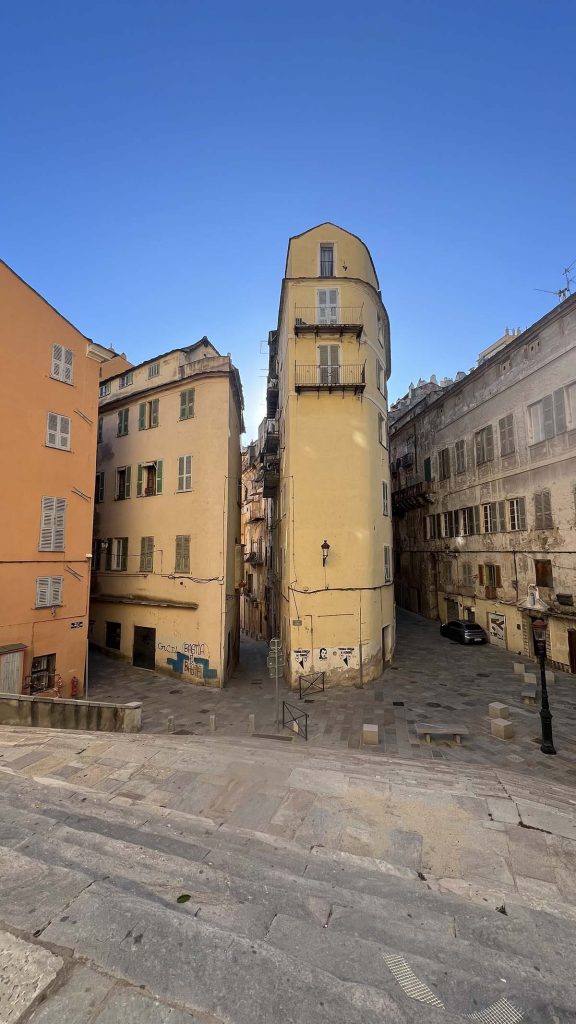ITINERARY
- Day 1: Arrival
- Day 2: Chamonix and Mont Blanc
- Day 3: Annecy City
- Day 4: Ferry arrival and camping check-in
- Day 5: Beach and Porto-Vecchio
- Day 6: Bonifacio
- Day 7: Vallee de Cavu—Journey to the Conca River Valley
- Day 8: Beach Day
- Day 9: Transfer to Restonica Valley camping
- Day 10: Hiking in the Restonica Valley
- Day 11: Corte
- Day 12: Transfer to San Damiano camping
- Day 13: Cap Corse
- Day 14: Bastia, Saint-Florent, Fornali Beach
- Day 15: Beach Day
- Day 16: Ferry to the mainland and journey home
- Brief Report
Day 12: Transfer to San Damiano Camping
The transfer took only an hour and a half, so we leisurely packed our things and bid farewell to the campsite where we had spent three unforgettable days. For three nights, we paid €94. Passing through Corte, we couldn’t resist stopping at the Casanova café one last time for breakfast to enjoy a final cup of coffee and an éclair before hitting the road.

On the way, we noticed some activity and a tourist bus. A quick online search revealed a small but historically significant Corsican site: the Pont Génois (or Pontu Ghjenuvese), one of the partially preserved Genoese bridges built in the 17th century. These historic bridges were crucial for connecting remote mountain areas to coastal settlements, ensuring safe crossings over turbulent rivers. Their arched construction and reliability symbolize Genoese rule, which lasted on the island for nearly four centuries. Despite being partially damaged, the stone arch still stands as a testament to the resilience and craftsmanship of that era—both an engineering marvel and a symbol of human ingenuity.

Carriolu, village imaginaire, a miniature village crafted with incredible detail and care, caught our attention nearby. The model features typical Corsican buildings: small stone houses with tiled roofs, cobbled streets, and a central square with a well. There are even miniature elements of village life—a bakery with tiny loaves of bread, a church with a bell tower, grazing sheep, and vineyards stretching along mountain slopes. Surrounded by greenery, with tiny trees, shrubs, and flowering plants, it feels like stepping into a living world. The small stream running through the model, complete with a miniature bridge, adds a serene touch to this depiction of Corsican rural life.

Nearby signs humorously yet sternly warn visitors against using the area as a toilet, threatening to “cut off the offender’s unmentionable parts.” This mix of serious historical elements with playful Corsican strictness is part of the island’s charm, where tradition and humor often intertwine.




By midday, we reached San Damiano Camping, where we planned to spend the final five nights before returning to the mainland. This comfortable four-star campsite boasts excellent amenities. Registration is streamlined through self-service terminals (much like McDonald’s, which, funnily enough, is absent from Corsica). The campsite offers a wide range of facilities: a swimming pool, children’s playgrounds, camper and tent spaces, as well as cabins. There’s also a large store, a restaurant, a fitness center, and modern, updated shower facilities.
The site is family- and pet-friendly, creating a lively and welcoming atmosphere.
Dogs are a story of their own on Corsica, where the island feels tailor-made for their enjoyment. Pets are welcome everywhere—shops, restaurants, beaches—and ferries even have dedicated dog-friendly areas. Campsites feature special dog showers near human facilities, which owners eagerly use to clean their sandy companions after a day on the beach. Despite the abundance of pets, cleanliness is impressively maintained, with no signs of chaos or noise—just relaxed dogs and their attentive owners. Corsica effortlessly creates a harmonious environment where animals coexist peacefully with humans.
The campsite is located right by the sea, though it’s not a place for solitude. However, it’s a convenient base for exploring northern Corsica, particularly the Cap Corse peninsula, which was our main goal.
Day 13: Cap Corse — Exploring Corsica’s Famous Cape

The drive along Cap Corse turned out to be an unexpected highlight of our trip. Initially, we planned to travel along the eastern coast to the fishing village of Macinaggio. However, the road itself became an adventure. A winding route along the coastline offered breathtaking views of rocky shores and the sea. Along the way, we encountered secluded beaches where we stopped to swim and relax.

Just 20 minutes after leaving Bastia, we arrived at the village of Erbalunga. Its picturesque narrow streets and old tower looked so inviting that we decided to stop for a stroll. This small village, with its medieval charm, felt like a step back into Corsica’s past.


The village of Erbalunga has changed little since its peak during the Genoese Republic. Walking through its quiet streets, you can feel the spirit of a time when life was simpler and more peaceful.


The road to Macinaggio was so scenic that we couldn’t resist venturing further, against our original plans. As we passed through rocky landscapes along the coastline, we frequently stopped at lookout points to take in the stunning views. One highlight was the old Cap Corse windmill, perched atop a hill and accessible via a short hike. From the top, a panoramic 360-degree view of mountains and sea unfolds, creating a sense of infinity.
We eventually arrived at Nonza, famous for its unique black sand beach. Locals and visitors alike create patterns and symbols with stones on the sand. From the tower above the beach, you can admire these unique “drawings” that look like ancient hieroglyphs. Nonza also boasts a restaurant with a stunning sea view, where you can enjoy traditional Corsican dishes. A meal of spiced lamb and a glass of local wine was the perfect accompaniment to the breathtaking scenery, making it feel as though life’s true flavor could be found right here.
The return journey down the mountain offered unbelievable views of the sea and the Gulf of Saint-Florent. It became clear that one day is far too short to explore Cap Corse — a peninsula rich in nature and history. We resolved to return someday to delve deeper into this enchanting region, filled with historic villages, hidden coves, and endless mountain vistas.
Day 14: Bastia — Exploring the Old Town and a Trip to Saint-Florent
Clean sea, sandy relaxation, the chance to swim, and the tranquility away from major tourist hubs.


We decided to explore Bastia early in the morning before heading to the northwest coast. Mornings are the best time for a stroll, as the city is just waking up, and the streets are still quiet. Without the crowds of tourists and with souvenir shops closed, you can peacefully enjoy the architecture and atmosphere.
Breakfast was at the cozy bakery Aux Délices de Miot (3 Rue Miot, 20200 Bastia, France). They offered a fantastic selection of fresh pastries: éclairs, custard-filled croissants, and excellent coffee — all at very reasonable prices.
Strolling through the quiet streets, we admired the houses built into the most unexpected spaces. Bastia’s architecture is a mix of shapes and sizes, with unique balconies adding even more charm. Suddenly, we emerged onto Place du Marché, which was buzzing with life. On Saturdays and Sundays, this square hosts a farmers’ market.

Visiting this market is a unique experience. You can see what locals buy and try traditional Corsican delicacies. We highly recommend the “migliaccioli” — Corsican pancakes with goat and sheep cheese cooked on the spot. Equally delicious are Beignets de fromage — pieces of Corsican brocciu cheese battered and fried. Additionally, you can find traditional sausages, Corsican cheeses, cured meats, and the famous Corsican honey.
On the way to Parking de la Citadelle, we stumbled upon a small pasta shop called Zia Maria. Two young Corsican women were busy making and selling fresh spaghetti and ravioli. We bought freshly packed spaghetti for two and even got a cooking tip — three minutes to perfection!

On Sundays, Bastia’s Saint-Nicolas Square transforms into a flea market, where locals sell anything they no longer need. Among the stalls packed with clothing and kitchenware, you’ll find tables with antique treasures, sometimes for just a few euros. Browsing and observing the trade here is fascinating, like visiting a mini open-air museum of local life and home decor.
One unforgettable moment we witnessed was an elegant man, likely in his sixties, examining a vintage knife. When he decided to buy it, instead of cash, he pulled out a checkbook and a fountain pen. With deliberate precision, he wrote the check, handed it to the vendor, who accepted it with respect and tucked it away without checking. It felt like a scene from the 1960s or ’70s — except for the man’s iWatch, a subtle nod to modernity. Such moments remind you that history here isn’t just a backdrop but a living, breathing part of everyday life.
Of course, we didn’t leave empty-handed. For just 50 cents, we bought a charming silver spoon with a twisted handle from an elderly couple clearing out their attic. Small, yet rich in history, it became a meaningful souvenir of this heartfelt and unique place.
Later, we headed to the northwest coast, hoping for calmer winds and a more peaceful sea. Our route took us to Saint-Florent along a winding, scenic mountain road. Several vineyards along the way offered tastings or the chance to buy local wine, especially muscat, for which the region is renowned.
After passing through Saint-Florent — a small but popular tourist town — we headed to Plage de Fornali. Instead of stopping at the main parking area, we continued along a dirt road that became narrower and bumpier. It led to an informal parking area, where the path continued only on foot.



A scenic coastal trail with numerous small beaches stretched along the coastline. Despite the wind, the walk was pleasant — cool and stunningly beautiful. The entire route to the farthest point takes about two hours and boasts breathtaking views. We found a sheltered cove with a perfect beach where the wind was absent, and the calm was complete.
We highly recommend this route for those who enjoy seaside hikes.
Day 15: Beach Day



The sea in Corsica is a true dream. The variety of beaches is astounding: from small, secluded ones to long, well-equipped stretches, with sandy, pebbly, or rocky shores. The water is incredibly clean, shimmering in shades of blue and turquoise, calm or with gentle waves. A rich underwater world makes snorkeling especially fascinating, and for diving enthusiasts, there are many centers along the coast.
The food in Corsica isn’t just good—it’s outstanding. A paradise for gourmets, especially those who love cheese. Sheep’s and goat’s cheese in all kinds of textures and ages—it’s an entire culture here, with a variety that’s truly impressive. You can buy it in any supermarket, but even better—directly at a farm. Alongside the roads, you’ll find signs saying “fromage direct vente,” pointing to hidden gems like Fromagerie des Cimes (6289-6527 Rte de Saint-Florent, 20600 Bastia, France)—a small shop with ancient vaulted ceilings where an elderly Corsican woman offers only two types of cheese and a few sausages—but what a selection! Aged to a stony consistency, the cheese melts in your mouth, and at €30 per kilogram, it feels like a steal for the quality you get.
Fromagerie des Cimes is a tiny shop tucked away on a mountain road. The name, which translates to “Cheese Dairy of the Peaks,” speaks for itself: here, at high altitudes with fresh air and sprawling pastures, cheeses with truly unique flavors are crafted. Inside, you’ll find old wooden shelves neatly lined with cheese wheels maturing under ideal conditions.
Corsican lamb also deserves a special mention—astonishingly tender and without a strong smell, it breaks all stereotypes about this type of meat. The lamb’s unique flavor comes from grazing on the island’s aromatic herbs. You can enjoy it in local restaurants, where chefs expertly grill it with rosemary and thyme, or buy it in stores to cook yourself and savor the authentic taste of Corsica.
Here’s the recipe we used to prepare Corsican grilled lamb with leeks:
Ingredients: Lamb (chops or ribs), Leeks, Garlic, Olive oil, Fresh rosemary and thyme, Lemon, Salt, and freshly ground black pepper to taste
Preparation:
1. For the marinade: In a bowl, mix olive oil, minced garlic, finely chopped rosemary and thyme leaves, the juice of half a lemon, salt, and pepper. Place the lamb in the bowl, ensuring every piece is coated. Let it marinate for at least 30 minutes.
2. Preparing the leeks: Wash the leeks thoroughly, remove the green tops, and cut the white parts into large chunks about 8-10 cm long. Place them in a separate bowl, drizzle with olive oil, and sprinkle with salt and pepper.
3. Grilling: Preheat the grill to medium heat. Place the lamb pieces on the grill and cook for 4-5 minutes on each side until golden. Simultaneously, add the leeks to the grill and roast them, turning occasionally, until soft and lightly caramelized.
4. Serving: Transfer the grilled lamb to a plate and let it rest for a couple of minutes. Arrange the roasted leeks alongside. Drizzle the dish with the remaining lemon juice and garnish with thyme sprigs. Bon appétit!
This recipe highlights the tenderness and natural flavors of Corsican lamb, complemented by the sweet and fresh notes of leeks, perfectly paired with the aroma of herbs.
Corsica is a place where even the simplest #foodie moments take on unexpected and delightful flavors.
Day 16


Day 16 marked the end of our Corsican adventure. Our ferry to the mainland was scheduled for 8 PM, leaving us ample time to spend the day exploring Bastia’s charming streets, filled with Mediterranean greenery. This city, with its cozy squares, harbor views, and historic quarters, left us with a sense of closure and contentment. Boarding the ferry, we carried with us countless memories of unforgettable days spent on this magical island. Corsica is a place that calls you back time and again, and we already know our journey here is far from over.

